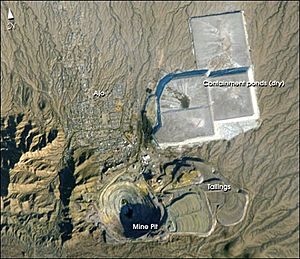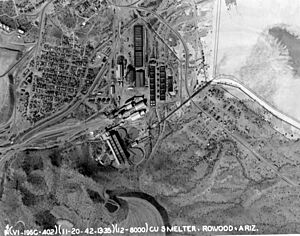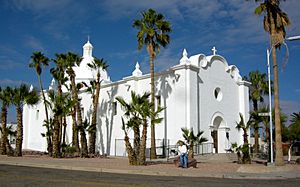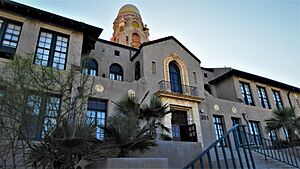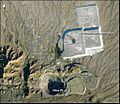Ajo, Arizona facts for kids
Quick facts for kids
Ajo
|
|
|---|---|
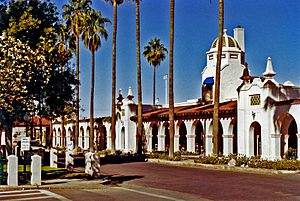
Ajo plaza in 1990
|
|
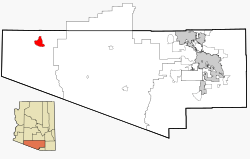
Location in Pima County and the state of Arizona
|
|
| Country | United States |
| State | Arizona |
| County | Pima |
| Area | |
| • Total | 33.33 sq mi (86.32 km2) |
| • Land | 33.33 sq mi (86.32 km2) |
| • Water | 0.00 sq mi (0.00 km2) |
| Elevation | 1,759 ft (536 m) |
| Population
(2020)
|
|
| • Total | 3,039 |
| • Density | 91.19/sq mi (35.21/km2) |
| Time zone | UTC-7 (MST (no daylight saving time)) |
| ZIP code |
85321
|
| Area code(s) | 520 |
| FIPS code | 04-00870 |
| GNIS feature ID | 0000538 |
Ajo (pronounced AH-hoh) is a small community in Pima County, Arizona, United States. It's not officially a city but a "census-designated place," which means it's a community grouped for statistics. Ajo is very close to the Organ Pipe Cactus National Monument, a famous natural area. In 2020, about 3,039 people lived there. You can find Ajo on Arizona State Route 85, about 43 miles (69 km) from the Mexican border.
Contents
History of Ajo
The name Ajo comes from the Spanish word for garlic. It's thought that the Spanish used this word because it sounded like the O'odham word for paint, oʼohoʼ'. The Tohono O'odham people, who are Native Americans, used to get red paint from this area.
Mining in Ajo
For a long time, people have been digging for valuable minerals in Ajo. Native Americans, then Spaniards, and later Americans, all found rich ore deposits here. In the early 1800s, there was a Spanish mine that was left empty because of attacks by Native Americans.
In 1847, a man named Tom Childs, Sr. found this old mine. It had a 60-foot (18 m) deep shaft, ladders made of mesquite wood, and buckets made from rawhide. He didn't stay long then, as he was heading to silver mines in Mexico.
Many years later, in 1884, Tom Childs and his son came back with a friend, Washington Michael Jacobs. They started working the abandoned mine again. Ajo became famous for its high-quality copper, making it the first copper mine in Arizona.
Copper Boom
In the mid-1880s, a company called Arizona Mining & Trading shipped copper all the way around Cape Horn to be processed in Wales. But it was hard to get supplies and there wasn't enough water, so the mine closed for a while.
Things changed in 1911 when new ways to get copper from lower-quality ore were discovered. Ajo then became a boomtown. A famous person named Col. John Campbell Greenway, who was a Rough Rider (a soldier in a special cavalry unit) and a Yale athlete, bought the New Cornelia mine. He made the mining operations much bigger.
To help the mining industry, the Tucson, Cornelia and Gila Bend Railroad was built in 1916. It brought supplies and took out copper until 1985. In 1921, Phelps Dodge, a very large copper company, bought the New Cornelia mine. For many decades, over 1,000 people worked in the huge open pit mine. Production stopped in 1985.
Today, Ajo is home to many retired people, Border Patrol agents, and young families.
Geography of Ajo
Ajo is located in the Little Ajo Mountains. The area is part of the Sonoran Desert, which means you can see many desert plants like saguaro cacti and ocotillos. A special plant called the Ajo lily, which looks like an onion, also grows here.
Two rare minerals were first found at the New Cornelia Mine in Ajo: ajoite and papagoite.
Climate in Ajo
Ajo has a hot desert climate. This means it gets a lot of sunshine all year. It doesn't rain much, except during certain times like the monsoon season. The wettest year on record was 1946, and the driest was 1928. Temperatures can get very hot, sometimes reaching 120°F (49°C) in July. In winter, it's usually mild, but it can get as cold as 17°F (-8°C).
| Climate data for Ajo, Arizona (1991–2020 normals, extremes 1915–present) | |||||||||||||
|---|---|---|---|---|---|---|---|---|---|---|---|---|---|
| Month | Jan | Feb | Mar | Apr | May | Jun | Jul | Aug | Sep | Oct | Nov | Dec | Year |
| Record high °F (°C) | 85 (29) |
92 (33) |
98 (37) |
105 (41) |
111 (44) |
119 (48) |
120 (49) |
118 (48) |
118 (48) |
109 (43) |
98 (37) |
88 (31) |
119 (48) |
| Mean maximum °F (°C) | 79.0 (26.1) |
82.5 (28.1) |
89.7 (32.1) |
97.4 (36.3) |
103.4 (39.7) |
110.4 (43.6) |
112.3 (44.6) |
111.0 (43.9) |
107.5 (41.9) |
100.4 (38.0) |
88.9 (31.6) |
79.2 (26.2) |
113.2 (45.1) |
| Mean daily maximum °F (°C) | 67.5 (19.7) |
70.5 (21.4) |
77.1 (25.1) |
84.0 (28.9) |
92.0 (33.3) |
101.1 (38.4) |
103.8 (39.9) |
103.0 (39.4) |
99.1 (37.3) |
89.2 (31.8) |
77.4 (25.2) |
66.6 (19.2) |
85.9 (29.9) |
| Daily mean °F (°C) | 56.2 (13.4) |
59.2 (15.1) |
64.5 (18.1) |
70.7 (21.5) |
78.8 (26.0) |
87.5 (30.8) |
91.7 (33.2) |
91.1 (32.8) |
86.8 (30.4) |
76.7 (24.8) |
64.2 (17.9) |
55.0 (12.8) |
73.5 (23.1) |
| Mean daily minimum °F (°C) | 44.9 (7.2) |
47.8 (8.8) |
51.8 (11.0) |
57.3 (14.1) |
65.5 (18.6) |
74.0 (23.3) |
79.7 (26.5) |
79.2 (26.2) |
74.4 (23.6) |
64.2 (17.9) |
51.0 (10.6) |
43.4 (6.3) |
61.1 (16.2) |
| Mean minimum °F (°C) | 34.6 (1.4) |
37.3 (2.9) |
40.9 (4.9) |
44.5 (6.9) |
52.9 (11.6) |
62.2 (16.8) |
70.1 (21.2) |
69.8 (21.0) |
63.7 (17.6) |
50.9 (10.5) |
40.2 (4.6) |
34.3 (1.3) |
31.9 (−0.1) |
| Record low °F (°C) | 17 (−8) |
22 (−6) |
27 (−3) |
33 (1) |
31 (−1) |
44 (7) |
58 (14) |
52 (11) |
41 (5) |
32 (0) |
30 (−1) |
22 (−6) |
17 (−8) |
| Average precipitation inches (mm) | 0.69 (18) |
0.80 (20) |
0.76 (19) |
0.17 (4.3) |
0.10 (2.5) |
0.08 (2.0) |
0.63 (16) |
1.43 (36) |
0.81 (21) |
0.44 (11) |
0.45 (11) |
0.62 (16) |
6.98 (176.8) |
| Average snowfall inches (cm) | 0.1 (0.25) |
0.0 (0.0) |
0.0 (0.0) |
0.0 (0.0) |
0.0 (0.0) |
0.0 (0.0) |
0.0 (0.0) |
0.0 (0.0) |
0.0 (0.0) |
0.0 (0.0) |
0.0 (0.0) |
0.0 (0.0) |
0.1 (0.25) |
| Average precipitation days (≥ 0.01 in) | 2.2 | 2.7 | 2.1 | 0.9 | 0.6 | 0.4 | 2.9 | 4.6 | 2.1 | 1.4 | 0.8 | 2.5 | 23.2 |
| Average snowy days (≥ 0.1 in) | 0.1 | 0.0 | 0.0 | 0.0 | 0.0 | 0.0 | 0.0 | 0.0 | 0.0 | 0.0 | 0.0 | 0.0 | 0.1 |
| Source: National Oceanic and Atmospheric Administration | |||||||||||||
Population of Ajo
| Historical population | |||
|---|---|---|---|
| Census | Pop. | %± | |
| 1920 | 2,336 | — | |
| 1930 | 4,571 | 95.7% | |
| 1950 | 5,817 | — | |
| 1960 | 7,049 | 21.2% | |
| 1970 | 5,881 | −16.6% | |
| 1980 | 5,189 | −11.8% | |
| 1990 | 2,919 | −43.7% | |
| 2000 | 3,705 | 26.9% | |
| 2010 | 3,304 | −10.8% | |
| 2020 | 3,039 | −8.0% | |
| source: | |||
Ajo first appeared in the U.S. Census in 1920. Its population grew a lot during the mining boom. In 1960, Ajo had its largest population with 7,049 people. At that time, it was the second-biggest community in Pima County, right after Tucson. Since then, the population has decreased, with 3,039 residents recorded in the 2020 census.
Education in Ajo
The Ajo Unified School District serves the students in Ajo. There is an elementary school, a middle school, and a high school, all located on the same campus. These schools are part of the Pima County Joint Technical Education District.
See also
 In Spanish: Ajo (Arizona) para niños
In Spanish: Ajo (Arizona) para niños
Images for kids



